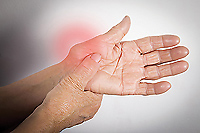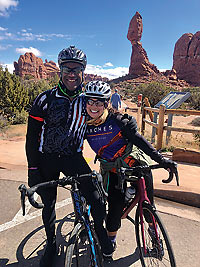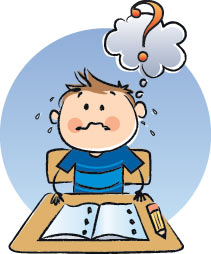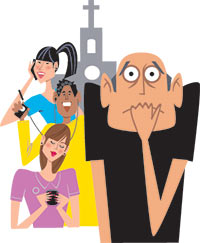|
|
HEALTHY HAPPENING March 2020
|
Arthritis and Available Treatment
|
Do you experience achy, painful and swollen joints in your fingers or thumbs? Have you noticed limitations in your ability to use your hands for everyday activities such as opening your water bottle or tying your shoes? If you answered yes to either of these questions, you may be experiencing symptoms of arthritis.
There are two main types of arthritis: rheumatoid arthritis and osteoarthritis. When either type of arthritis begins causing problems in the hands or fingers, seeking hand therapy from an occupational therapist (OT) can be an important part of learning how to control pain and preserve hand function in order to complete your normal daily activities. While both types of arthritis manifest some similar symptoms, there are some important differences.
 Rheumatoid arthritis is an autoimmune disorder in which a person’s immune system attacks his or her own body tissues, resulting in swollen, painful and sometimes deformed joints (Mayo Clinic, 2019). Pain and inflammation from rheumatoid arthritis typically occurs all over the body, with problems in many or all of the joints. If it is untreated, rheumatoid inflammation can lead to disfigured or even collapsed joints and can impair normal daily activities. When rheumatoid arthritis is diagnosed early, medical treatments can greatly decrease pain and can slow or even prevent the disfiguring of joints. OT hand therapy is often a vital part of treatment if rheumatoid arthritis is within your hands. OT treatments can reduce chronic hand pain with specific training for strategies to use in daily life that will preserve joint functioning long term. Rheumatoid arthritis is an autoimmune disorder in which a person’s immune system attacks his or her own body tissues, resulting in swollen, painful and sometimes deformed joints (Mayo Clinic, 2019). Pain and inflammation from rheumatoid arthritis typically occurs all over the body, with problems in many or all of the joints. If it is untreated, rheumatoid inflammation can lead to disfigured or even collapsed joints and can impair normal daily activities. When rheumatoid arthritis is diagnosed early, medical treatments can greatly decrease pain and can slow or even prevent the disfiguring of joints. OT hand therapy is often a vital part of treatment if rheumatoid arthritis is within your hands. OT treatments can reduce chronic hand pain with specific training for strategies to use in daily life that will preserve joint functioning long term.
Osteoarthritis is the most common type of arthritis. It is a degenerative joint disease where changes in joint tissue cause the smooth ends of bone surfaces to wear down at the joint (The National Institute of Arthritis and Musculoskeletal and Skin Diseases, 2019). Symptoms of osteoarthritis may include pain, stiffness and/or swelling in a joint, but it typically affects individual joints, rather than causing flare ups all over the body. Some think osteoarthritis mainly affects the larger joints of the body (hips, knees, neck, back, etc.), but when it occurs in the smaller joints like hands, fingers and thumbs it can complicate daily life.
Once-simple tasks like twisting the handle on a can opener, or the precise pinch needed for wiggling a shirt button into place can cause intense pain. In the fingers in particular, osteoarthritis can lead to bony joint changes and cause joint “nodes” or deformities. If you have osteoarthritis in your hands, OT hand therapy can help by providing evidence-based interventions to decrease hand pain and to protect your joints from deformities. OT treatments may include therapeutic exercises, pain-reducing procedures, or customized splinting to protect inflamed joints. OT can also train you on ways to modify daily activities to decrease joint strain and other strategies for managing pain.
Elynn Schriber, MOTR/L specializes in Hand Therapy right here in Moab, UT. She is an Occupational Therapist who provides hand therapy services at the Precision Rehabilitation clinic located at 1030 Bowling Alley Lane (Suite 3). In addition to treating patients with arthritis, she is trained in treating many other common conditions and injuries of the hand and elbow. Ask your doctor for a referral for hand therapy to begin treatment today.
Sources:
Mayo Clinic Staff. “Arthritis.” Mayo Clinic, Mayo Foundation for Medical Education and Research, 19 July 2019. www.mayoclinic.org/diseases-conditions/arthritis/
The National Institute of Arthritis and Musculoskeletal and Skin Diseases. “Osteoarthritis.” National Institutes of
Health. Oct. 2019. www.niams.nih.gov/health-topics/osteoarthritis.
|
Staying Healthy with your Primary Care Provider |
Regularly seeing the same Primary Care Provider throughout your life provides numerous benefits. Scheduling and attending your annual appointments can help to cultivate a healthy provider/patient relationship. When the relationship with your Primary Care Provider is strong, they’ll have access to your full health history and know how to advocate for you and your health. They’ll also have your family’s health history and understand the health risks unique to you.
Annual appointments are important throughout your entire life. When you schedule your annual appointment, there’s a physical exam involved as well as preventative services such as screenings for high blood pressure, blood sugar, and cholesterol.
Young children are seen more frequently. The American Academy of Pediatrics recommends the following schedule from birth to age three. Keep in mind that your Primary Care Provider may choose a slightly different approach, depending on your child’s specific health needs.
- The first week visit
- (3 to 5 days old)
- 1 month old
- 2 months old
- 4 months old
- 6 months old
- 9 months old
|
- 12 months old
- 15 months old
- 18 months old
- 2 years old (24 months)
- 2 ½ years old
- (30 months)
- 3 years old
|
After 3 years of age, visits to a Primary Care Provider are recommended annually for the remainder of your years. The purpose of these visits is to track growth and development with a focus on prevention at each milestone.
Additional Benefits of Seeing Your Primary Care Provider
If you’re needing to see a specialist, your Primary Care Provider can often provide advice or treatment in the interim. Some specialists schedule a few months out, so it can be helpful to visit with your Primary Care Provider regularly during your scheduled appointments. They can also help answer any general health questions or concerns that you have.
Our Primary Care Providers
We offer a diverse group of experienced and compassionate Primary Care Providers who are currently accepting new patients. When it comes to your family and your healthcare, we understand how important it is to find the right medical provider. We are committed to providing lifelong exceptional care to you and your family. It is our goal for you to live a healthy, vibrant, and well-balanced life. We know you’ll be well cared for by our excellent providers at Moab Regional Hospital.
|
Skinny Tire Festival for a Good Cause
by Beth Logan |
 After losing his older brother to cancer, Mark Griffith wanted to find a way to deal with his grief. He wanted to do something. He put purpose to his cycling and began the Moab Skinny Tire Festival with a few close friends to raise money for cancer survivorship programs. After losing his older brother to cancer, Mark Griffith wanted to find a way to deal with his grief. He wanted to do something. He put purpose to his cycling and began the Moab Skinny Tire Festival with a few close friends to raise money for cancer survivorship programs.
Twelve riders signed up that first year and raised $1200. Twenty years later, thousands of cyclists have participated and donated over $6 million to a variety of cancer foundations and beneficiaries. In Moab, the cancer treatment facility at the Moab Regional Hospital is funded in part by the Skinny Tire Festival cyclists, all whom have made donations to benefit local Moab residents seeking cancer treatment.
Moab’s Skinny Tire Events are not only fund raisers for cancer research and survivorship, but are intended to create an experience that uplifts, rewards and rejuvenates on many levels — physically with the cycling challenges, emotionally and mentally with shared stories from others about their cancer situations, losses, etc., and spiritually in the unique way that only nature can accomplish.
Evelyn and Earnest can’t wait for their fourth Skinny Tire Festival. “When riding Day 1 four years ago I was scared and had my doubts about being able to tackle the hills in Moab” said Evelyn. “We don’t have hills in Chicago! When I reached those steep hills, I approached it like I did my life & marriage. Getting ready for a big climb, I just put my head down, said a prayer, and broke it down one pedal at a time. I would listen out for encouraging words from other cyclists passing, shouting “we got this!”. Often I wanted to cry and give up but my village, fellow cyclists, didn’t let me quit. I would be reminded to look up and focus on the view & see how far we’ve climbed. When I did, I felt motivated and re-energized and was able to continue the climb. What an amazing view at the top!! A big lesson I learned is that even when you’re struggling with anything in life, don’t put your head down. Look up, breathe, embrace the challenges, enjoy the moment as difficult as it might seem and see how far you’ve come!”
Some enjoy the Skinny Tire Festival for the early spring riding; others, like Evelyn, it’s about seeing an obstacle and knowing you can get through it. The scenery inspires... helps one think, experience, rejuvenate & regenerate.
Would you like to participate? Contact TEAM SKINNY at 435.260.8889 or info@skinnytireevents.com.
Skinny Tire Festival
Cycling Routes
- Saturday, March 14th, Moab Bike Path & Hwy 313 to Dead Horse Point State Park*
- Sunday, March 15th, Hwy 128 Colorado River Corridor
- Monday, March 16th, Arches National Park
- Tuesday, March 17th, Hwy 279 River Portal Route
*Saturday’s route coincides with the finish area of the half marathon at Lions Park. Event organizers are working together to make this as smooth as possible.
|
|
Anxiety Comes in Different Forms
by Stephen Proskauer, M.D. |

The simplest form of anxiety is Phobia – like arachnophobia, fear of spiders, or claustrophobia,fear of confined spaces. Sometimes phobias have a clear cause, like fear of water after a narrow escape from drowning. Phobias respond to gradually increasing exposure – for instance, first getting comfortable with a picture of a small spider, then a larger spider, then a real dead spider, then a live spider across the room, etc, until over time you might learn to hold a harmless garden spider in your hand without freaking out.
Next is a common condition, Generalized Anxiety Disorder (GAD), constant worry about anything and everything – in other words, praying for what you don't want. GAD is usually treated with SSRI drugs and psychotherapy. Meditation can help calm the worrying mind.
Then there is that fight or flight reaction, when your heart thumps fast and you breathe in short gasps and sweat and tremble and feel like something terrible is going to happen, like you are about to die. This is called Panic Disorder and it responds to various calming drugs. Social Anxiety Disorder and Performance Anxiety can be treated as particular forms of Panic Disorder.
 Posttraumatic Stress Disorder (PTSD) is caused by exposure to overwhelming trauma, originally called “battle fatigue” in disabled soldiers. In PTSD, the brain is sensitized by trauma to be hypervigilant and get triggered by harmless stimuli that reactivate traumatic memories, like a war veteran hitting the sidewalk when a car backfires. Typical PTSD symptoms include preoccupation with the trauma, flashbacks, nightmares, and phobic avoidance. Children have been traumatized physically, sexually or emotionally can also develop PTSD. There are many treatment methods to calm the oversensitized brain in PTSD. Posttraumatic Stress Disorder (PTSD) is caused by exposure to overwhelming trauma, originally called “battle fatigue” in disabled soldiers. In PTSD, the brain is sensitized by trauma to be hypervigilant and get triggered by harmless stimuli that reactivate traumatic memories, like a war veteran hitting the sidewalk when a car backfires. Typical PTSD symptoms include preoccupation with the trauma, flashbacks, nightmares, and phobic avoidance. Children have been traumatized physically, sexually or emotionally can also develop PTSD. There are many treatment methods to calm the oversensitized brain in PTSD.
Obsessive Compulsive Disorder (OCD) seems to arise from the effort to prevent anxiety magically through repetitive thoughts or rituals, such as compulsive counting or hand-washing or checking repeatedly to make sure doors are locked. OCD responds to drugs like fluvoxamine.
Bipolar anxiety also involves fear of losing control. The bipolar patient thinks the problem is with job or family or the world situation, but this is a projection of chaos in the brain. With effective treatment of the Bipolar Disorder, this fear subsides.
Anxiety generally tends to be accompanied by rapid shallow breathing. Consciously switching to slow deep breathing reduces anxiety and helps reengage with the present moment – the warm sunshine and the familiar sounds of life.
|
| |
|
|
|
|
|
|
|
© 2002-2024 Moab Happenings. All rights
reserved.
Reproduction of information contained in this site is
expressly prohibited.
|
|